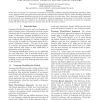Free Online Productivity Tools
i2Speak
i2Symbol
i2OCR
iTex2Img
iWeb2Print
iWeb2Shot
i2Type
iPdf2Split
iPdf2Merge
i2Bopomofo
i2Arabic
i2Style
i2Image
i2PDF
iLatex2Rtf
Sci2ools
LREC
2008
2008
A Comparative Study on Language Identification Methods
In this paper we present two experiments conducted for comparison of different language identification algorithms. Short words-, frequent words- and n-gram-based approaches are considered and combined with the Ad-Hoc Ranking classification method. The language identification process can be subdivided into two main steps: First a document model is generated for the document and a language model for the language; second the language of the document is determined on the basis of the language model and is added to the document as additional information. In this work we present our evaluation results and discuss the importance of a dynamic value for the out-of-place measure.
Education | Language Identification | Language Identification Algorithms | Language Model | LREC 2008 |
| Added | 29 Oct 2010 |
| Updated | 29 Oct 2010 |
| Type | Conference |
| Year | 2008 |
| Where | LREC |
| Authors | Lena Grothe, Ernesto William De Luca, Andreas Nürnberger |
Comments (0)

